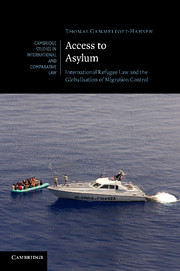Book contents
- Frontmatter
- Contents
- Foreword
- Preface
- Acknowledgements
- Table of treaties and other international instruments
- Table of cases
- 1 Introduction
- 2 The refugee and the globalisation of migration control
- 3 Refugee protection and the reach of the non-refoulement principle
- 4 Offshore migration control and the concept of extraterritorial jurisdiction
- 5 The privatisation of migration control and state responsibility
- 6 ‘Hic abundant leones’: the institutional reach of refugee protection
- 7 Conclusion
- Bibliography
- Index
- CAMBRIDGE STUDIES IN INTERNATIONAL AND COMPARATIVE LAW
6 - ‘Hic abundant leones’: the institutional reach of refugee protection
Published online by Cambridge University Press: 03 May 2011
- Frontmatter
- Contents
- Foreword
- Preface
- Acknowledgements
- Table of treaties and other international instruments
- Table of cases
- 1 Introduction
- 2 The refugee and the globalisation of migration control
- 3 Refugee protection and the reach of the non-refoulement principle
- 4 Offshore migration control and the concept of extraterritorial jurisdiction
- 5 The privatisation of migration control and state responsibility
- 6 ‘Hic abundant leones’: the institutional reach of refugee protection
- 7 Conclusion
- Bibliography
- Index
- CAMBRIDGE STUDIES IN INTERNATIONAL AND COMPARATIVE LAW
Summary
In the British Library hangs one of the earliest maps of Europe. The Cotton Tiberius Map bears few resemblances to modern maps, but it represents the world as it was known at around the first millennium ad. The cartographer may have been aware that some areas were a little sketchy and largely unexplored. In the top left corner, near the east coast of Asia, one thus finds a drawing of a lion and the inscription, ‘Hic abundant leones’. Since then, the expression ‘here lions abound’ has been copied by several cartographers to describe partly or wholly uncharted territories. More generally, the expressions ‘here be lions’ or ‘here be dragons’ have occasionally been used to imply that on this or that issue little is known and less can thus be said with any degree of certainty.
Today, few such places remain on geographical maps. Satellite images and the Global Positioning System (GPS) ensure that we have constant access to an updated picture of the world around us. Not only is this knowledge used to ensure our own navigation, it has also become a key tool in the attempt by governments to control or manage migration flows and international travel. Examples of the surveillance technologies employed for this purpose have already been mentioned in the previous chapters: carriers and visa consulates forward biometric data, immigrant and asylum-seeker databases are growing, and radar stations, satellites, warships and airborne warning and control systems (AWACS) are being used to monitor irregular migrants at many of the world's migratory hot spots.
- Type
- Chapter
- Information
- Access to AsylumInternational Refugee Law and the Globalisation of Migration Control, pp. 209 - 230Publisher: Cambridge University PressPrint publication year: 2011

